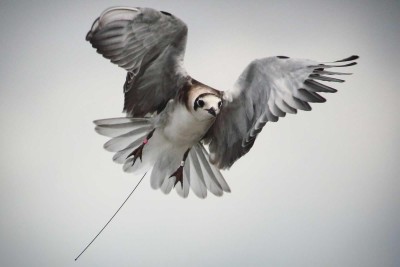Erin Rowan, guest author, is the Senior Conservation Associate with Audubon Great Lakes and is based in Michigan.
The Black Tern (Chlidonias niger surinamensis) is a marsh bird species that has experienced severe long-term population declines in the Great Lakes region, with a 70% loss in Michigan alone. Precise estimates of Black Tern fledging success are non-existent and knowledge of the demographic drivers of Black Tern population dynamics is limited. The Upper Mississippi River and Great Lakes Region Joint Venture (UMRGLRJV) Waterbird Habitat Conservation Strategy highlights the need for more demographic data for Black Terns to clarify whether recovery efforts should focus on breeding grounds or on stopover/wintering areas. Specifically, given that the stage between hatching and dispersal/migration can have a major effect on bird population dynamics, recent work has identified characterization of Black Tern fledging rates as a high-priority information need. It is clear that evaluation of population parameters encompassing the full annual cycle is necessary to ascertain the demographic source(s) most responsible for Black Tern population trends.
With the help of project partners, Audubon Great Lakes built three Motus towers throughout Southeast Michigan to detect fledged Black Tern chicks as they depart their nesting grounds. 19 NanoTags were deployed on pre-fledged Black Tern chicks in 2019-2020, four of which were redetected as fledglings outside of their nesting grounds. “Our early analysis shows that Black Tern colonies in the Great Lakes are successfully producing young, suggesting that the greatest threat could likely occur during migration or winter on the open ocean,” said Sarah Saunders, Qualitative Ecologist for National Audubon Society. “We’re on the edge of solving this conservation puzzle. By tagging more birds and adding additional towers this year, later this fall we hope to have a clearer picture on what is driving population loss.” 28 pre-fledged Black Tern chicks were successfully tagged during the 2021 field season and we are excited to learn from them as they travel south.
The objectives of this project were three-fold:
- Affix Avian NanoTags on Black Tern chicks to improve monitoring of pre-fledged and fledged young at three study locations, enabling a regional (Upper Great Lakes) perspective;
- Synthesize long-term population abundance indices, nest monitoring, ongoing mark-recapture data, and nanotag data into an integrated population model (IPM) to obtain more precise estimates of key demographic parameters (productivity, fledging success, sub-adult survival, and annual adult survival); and
- Conduct a sensitivity analysis to assess whether Black Tern population dynamics are more strongly correlated with reproduction (i.e., productivity, fledging success) or annual survival.
This research is a critical first step in allowing managers to identify when and where in the annual cycle to focus conservation and restoration efforts to slow/reverse Black Tern population declines in the Upper Great Lakes. Learn more about Audubon Great Lakes Black Tern research here.

